Digital Poster
MR Safety I
ISMRM & ISMRT Annual Meeting & Exhibition • 03-08 June 2023 • Toronto, ON, Canada

| Computer # | |||
|---|---|---|---|
2686.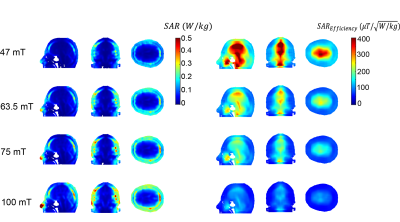 |
161 |
Specific Absorption Rate (SAR) Simulations for Ultra-low-field
(<0.1 T) MRI Systems
Javad Parsa1,2 and
Andrew Webb1
1C.J.Gorter MRI center, Department of Radiology, Leiden University Medical Center, Leiden, Netherlands, 2Percuros B.V., Leiden, Netherlands Keywords: Low-Field MRI, Safety, specific absorption rate, transmit efficiency, electromagnetic simulations Simulations of the magnetic and electric fields produced by RF coil commonly used at ultra-low field systems (from 0.05 to 0.1 tesla) have been performed. The highest SAR locations is present in tissues such as the nose and skull that are closest to the coil. Based on these simulations, the specific absorption rate (SAR) efficiency can be derived to ensure safe operation on point-of-care (POC) MRI systems. |
|
2687.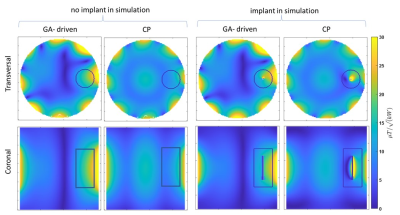 |
162 |
Rapid transfer function-based transmission field shimming for
safe and B1+ artefact free MRI of implantation sites
Mostafa Berangi1,2,3,
Helmar Waiczies2,
and Thoralf Niendorf1,2,3
1Berlin Ultrahigh Field Facility (B.U.F.F.), Berlin, Germany, 2MRI.TOOLS GmbH, Berlin, Germany, 3Charité – Universitätsmedizin Berlin, Berlin, Germany Keywords: Safety, Parallel Transmit & Multiband Fixation of bone fractures with screws is common clinical practical including follow-up monitoring of the implantation site and of the healing process. MRI-based monitoring can be compromised by tissue heating and transmission field distortion. To overcome this challenge, this work uses parallel transmission using an optimal transmission vector. The proposed approach leverages a single EMF simulation without the implant, while the effect of implant electromagnetic scattered fields are estimated using a transfer matrix. Optimal shim vectors are computed by an optimization process using a multilevel genetic algorithm. Our findings demonstrate the feasibility and performance of the transfer function driven approach. |
|
2688.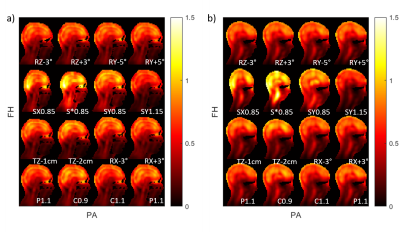 |
163 |
Workflow proposal to test SAR virtual observation points with
convex optimization: application to intersubject variability at
11.7T MRI
Vincent Gras1,
Edouard Chazel1,
Nicolas Boulant1,
Alexis Amadon1,
and Michel Luong1,2
1CEA, CNRS, BAOBAB, Neurospin, University of Paris Saclay, Gif sur Yvette, France, 2IRFU, Paris Saclay University, Gif-sur-Yvette, France Keywords: Safety, Brain Connectivity Efficient monitoring of the specific absorption rate (SAR) in parallel-transmission MRI is performed by evaluating the RF power deposition on specific SAR matrices called Virtual Observation Points (VOPs). But given the various sources of uncertainties that occur in practice (head placement, anatomy, precision of the body model to name a few), a challenging task remains to determine a suitable safety margin to be applied on the VOPs to offer a tradeoff between safety and scanning performance. In this work, as a first step towards this, we propose a workflow to tackle this problem for brain imaging at 11.7 Tesla. |
|
2689.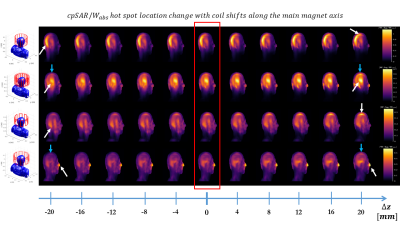 |
164 |
Large-scale Modelling of Patient Motion for Head Coils at 7T
Amer Ajanovic1,2,
Raphael Tomi-Tricot1,2,3,
Joseph V Hajnal1,2,
and Shaihan Malik1,2
1Biomedical Engineering Department, School of Biomedical Engineering and Imaging Sciences, King's College London, LONDON, United Kingdom, 2London Collaborative Ultra high field System (LoCUS), London, United Kingdom, 3MR Research Collaborations, SIEMENS Healthcare Limited, Frimley, United Kingdom Keywords: Safety, Simulations, ultra-high field, RF arrays and systems, parallel transmit coils The aim of this study is 2-fold. First, it is to demonstrate the practicality of using MARIE workflow to generate models with variation due to patient pose/motion. The second aim is to explore use of a simple 1st order linear model to visualise and predict the variation in B1+ and SAR with pose. Consequently, 4 different coils are simulated in more than 2200 positions with respect to body. Low variability in key metrics is observed. 1st order linear model relating position with these metrics is found to further reduce variability. |
|
2690.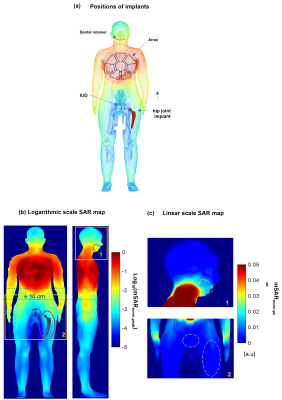 |
165 |
Relaxing exclusion criteria for human subjects in the UHF
cardiac MRI with 8Tx/16Rx cardiac array using the SAR analysis
for conductive implants.
Maxim Terekhov1,
Ibrahim A. Elabyad1,
David Lohr1,
and Laura M. Schreiber1
1Chair of Molecular and Cellular Imaging, Comprehensive Heart Failure Center, University Hospital Würzburg, Wuerzburg, Germany Keywords: RF Arrays & Systems, Safety The incomplete consensus regarding SAR safety in ultra-high-field MRI leads to a large variety of exclusion criteria for volunteer cohorts in the different centers, especially regarding the acceptance of conductive implants. Therefore, SAR analysis of new commercial transceiver arrays contributes to supplying local IRBs with information regarding the safety of human subjects. This study aimed to analyze SAR for a prototype of a new 8Tx/16Rx array for 7T cardiac MRI. The main goal was to analyze the array safety for human subjects with a different type of passive implant located outside of the array borders. |
|
2691.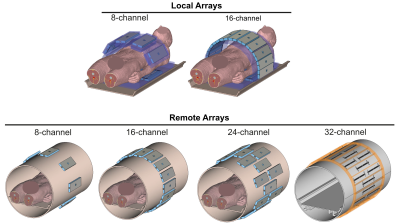 |
166 |
Local and Whole-Body SAR in UHF Body Imaging: Implications for
Matrix Compression
Thomas M. Fiedler1,
Mark E. Ladd1,
and Stephan Orzada1
1German Cancer Research Center (DKFZ), Heidelberg, Germany Keywords: Safety, RF Arrays & Systems RF safety of multi-channel transmit arrays is supervised with a set of matrices representing local SAR or whole-body SAR. As transmit arrays for body imaging have characteristics of both volume and local transmit coils, this study evaluates both SAR aspects: local and whole-body SAR. In all evaluated cases, the local SAR limit was reached before the whole-body SAR. Nevertheless, the whole-body SAR matrix can be used to reduce the number of local SAR matrices, reducing memory and computing time. |
|
2692.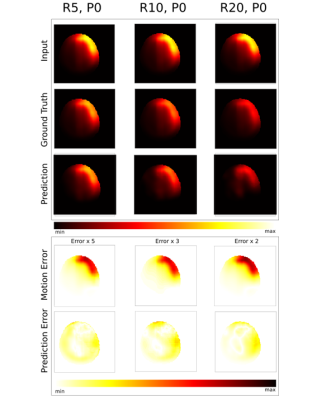 |
167 |
Towards Applying Deep Learning to Predict Rigid Motion-Induced
Changes in Q-matrices from UHF-MRI pTx Simulations
Katherine Anna Blanter1,
Alix Plumley1,
Shaihan Malik2,
and Emre Kopanoglu1
1Psychology, Cardiff University Brain Research Imaging Centre, Cardiff University, Cardiff, United Kingdom, 2Life Sciences & Medicine, Biomedical Engineering & Imaging Sciences, Department of Biomedical Engineering, King's College London, London, United Kingdom Keywords: Safety, Parallel Transmit & Multiband, Specific absorption rate (SAR), ultra-high field MRI, deep learning Patient motion affects the specific absorption rate (SAR), a safety parameter in MRI. SAR is often calculated using so-called Q-matrices. We used conditional generative adversarial networks (cGANs) to estimate the effect of motion on magnitude from Q-matrices, which were extracted from body models simulated in a parallel-transmit (pTx) coil tuned to operate at 7T. Networks trained on Q-matrices from two positions were extrapolated to nine others. Network-predicted Q-matrices corresponded well with simulated ground truth motion-affected Q-matrices. |
|
2693.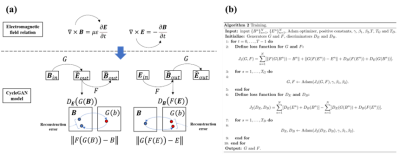 |
168 |
Patient-specific Local SAR estimation by combined field mapping
and deep-learning method
Shao Che1,2,
Zhuoxu Cui1,2,
Jin Liu3,
Siyuan Ding3,
Peng Cao4,
Xiaoliang Zhang5,
Xin Liu1,2,
Hairong Zheng1,2,
Dong Liang1,2,
and Ye Li1,2
1Lauterbur Research Center for Biomedical Imaging, Shenzhen Institute of Advanced Technology, Chinese Academy of Sciences, Shenzhen, China, 2Key Laboratory for Magnetic Resonance and Multimodality Imaging of Guangdong Province, Shenzhen, China, 3United Imaging Research Institute of Innovative Medical Equipment, Shenzhen, China, 4The University of Hong Kong, Hongkong, China, 5Biomedical Engineering, State University of New York at Buffalo, Buffalo, NY, United States Keywords: Safety, Safety A method is proposed for real time patient-specific local SAR estimation based on B1 field mapping and machine-learning. The axial component of RF E-field is estimated by electric property tomography (EPT) method from B1 field, and the transversal component of RF E-field is predicted by a cycleGAN model trained with EM simulation input data. The safety factor of peak local SAR estimation is analyzed for a large set of random transmit weighting factors and the feasibility of the method is discussed. |
|
2694.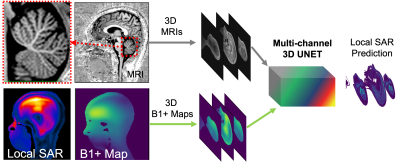 |
169 |
Experimental Validation of Deep Learning Based Local SAR Mapping
from 3D B1+ and Localizer-like MRIs for 7T pTx Systems
Sayim Gokyar1,
Chenyang Zhao1,
and Danny JJ Wang1,2
1USC Stevens Neuroimaging and Informatics Institute, Keck School of Medicine, University of Southern California, Los Angeles, CA, United States, 2Department of Neurology, Keck School of Medicine, University of Southern California, Los Angeles, CA, United States Keywords: Safety, Safety, Local SAR Prediction Local SAR related heating is a limiting safety factor at UHF MRI. Since local SAR cannot be measured, it should either be estimated from the global SAR or predicted by using the available data such as B1+ maps and MRIs. Here we proposed to use a multi-channel 3D CNN to utilize different channels for B1+ maps and MRIs simultaneously to improve local SAR prediction. We validated our method on 6 participants and found that maximum SAR values can be predicted with 80% accuracy, and local SAR variation can be predicted over 95% accuracy by using common image similarity metrics. |
|
2695. |
170 |
An open-source, low-cost 8-channel transmit/receive 3T head coil
for pTx developments, MR safety testing and standardization
Christoph Stefan Aigner1,
Mads Sloth Vinding2,
Lukas Winter1,
Reiner Montag1,
Sebastian Schmitter1,3,4,
Bernd Ittermann1,
and Frank Seifert1
1Physikalisch-Technische Bundesanstalt (PTB), Berlin and Braunschweig, Germany, 2Aarhus University, Center of Functionally Integrative Neuroscience (CFIN), Department of Clinical Medicine, Faculty of Health, Aarhus, Denmark, 3Medical Physics in Radiology, German Cancer Research Center (DKFZ), Heidelberg, Germany, 4University of Minnesota, Center for Magnetic Resonance Research, Minneapolis, MN, United States Keywords: RF Arrays & Systems, New Devices This work investigates an open-source, low-cost 8-channel transmit/receive head coil to enable rapid and reproducible pTx development, safety assessment and evaluation at 3T. FDTD simulations were validated with phantom measurements on a 3T with an external pTx system. Relative and absolute 2D/3D B1+-maps were acquired to compute the CP+ mode, and two RF shims were tailored to enforce B1+ efficiency and homogeneity. The open-access design files could serve as a basis for new RF coil designs or pTx projects without needing high expertise in RF coil development or as a cost-effective alternative for multi-centre studies. |
|
2696.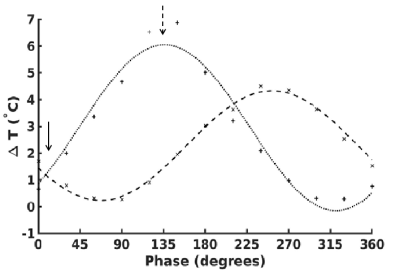 |
171 |
Temperature rise modelling framework for multiple electrode
configurations on parallel transmit systems.
Jagjit S Sidhu1,
Ken Sakaie1,
Pallab K Bhattacharyya1,
and Mark Lowe1
1Cleveland Clinic, Cleveland, OH, United States Keywords: Safety, Safety Implanted electrodes can induce unsafe heating during MRI. Developing safe MRI protocols can be a burdensome process, involving intensive simulations that are hard to tailor to individual patients. To increase the feasibility of safe imaging of patients with implanted electrodes, we extend previous work, that nulled induced currents when the number of transmitters exceeded the number of electrodes, to account for the case when these are equal or the number of electrodes exceeds the number of transmitters. In such cases, complete nulling (no measured temperature rise) is impossible in all electrodes unless an acceptable induced temperature rise is allowed. |
|
2697. |
172 |
Optimized model architecture and generalization for deep
learning-based SAR prediction (MRSaiFE)
Mina Chookhachizadeh Moghadam1,
Nawal Panjwani2,
Elizaveta Motovilova1,
Mengying Zhang 1,
Fraser Robb3,
Adrian Hoang1,
Tasmia Afrin1,
and Simone Angela Winkler1
1Radiology, Weill Cornell Medicine, New York, NY, United States, 2Tandon School of Engineering, New York University, New York, NY, United States, 3GE Healthcare, Aurora, OH, United States Keywords: Safety, High-Field MRI, Deep Learning, SAR prediction, Tissue heating Predicting the SAR distribution in ultra-high field MRI is a crucial task to prevent tissue damage due to the hotspots, though it is challenging. The MRSaiFE deep learning framework predicts SAR based on anatomical images, but it does not guarantee model generalization due to data leakage in the training process. To improve the model, we extended the UNet architecture to include residual and inception modules in its encoder part. Further, we implemented customized loss functions, and evaluation metrics to improve the predictive performance. The results show that the model predicts SAR with an SSIM=86% and MSE=0.14% for unseen body models. |
|
2698.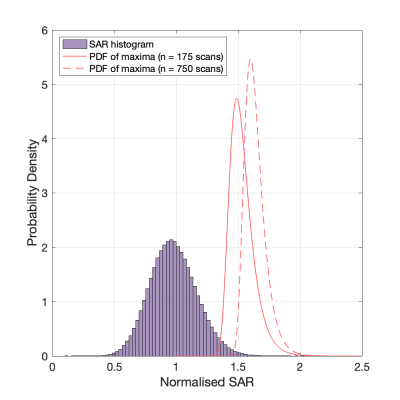 |
173 |
Extreme Value Theory as a Risk Analysis Tool to Infer Specific
Absorption Rate Intersubject Variability Safety Margins
Igor Tyshchenko1,
Simon Lévy2,
Bahman Tahayori3,
and Leigh A. Johnston1
1Department of Biomedical Engineering, The University of Melbourne, Melbourne, Australia, 2MR Research Collaborations, Siemens Healthcare Pty Ltd, Melbourne, Australia, 3The Florey Institute of Neuroscience and Mental Health, Melbourne, Australia Keywords: Safety, Parallel Transmit & Multiband, Safety margins, SAR estimation Specific absorption rate (SAR) in parallel transmission (pTx) ultra-high field MRI is typically evaluated by performing offline electromagnetic simulations on a generic human model. Conventionally, a safety margin that addresses the issue of intersubject variability is selected by choice of the 99th or higher percentile of the SAR distribution. In this work, we argue that this approach underestimates the risk of exceeding the SAR limit. As an alternative, we propose the use of Extreme Value Theory (EVT) for controlling the probability of extremal events in the form of large SAR deviations. |
|
2699.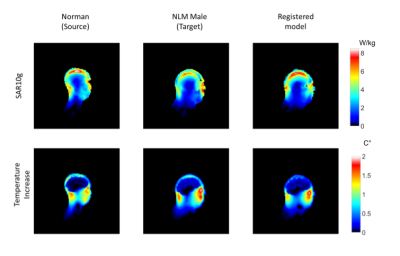 |
174 |
SAR and Temperature Safety Assessment on Patient Specific Models
Generated with a Registration Method
Giuseppe Carluccio1,2,
Eros Montin1,
Christopher Michael Collins1,2,
and Riccardo Lattanzi1
1Radiology, NYU Grossman School of Medicine, New York, NY, United States, 2Center for Advanced Imaging Innovation and Research (CAI2R), New York University, New York, NY, United States Keywords: Safety, Safety Patient specific models are required to improve the accuracy of the simulations to perform safety assessment related to interaction of the RF fields with the body tissues. One registration method allows non-rigid transformations: this can be used to reshape a numerical body model to match the images of a patient, and generate a model similar to the shape of the patient. We performed SAR and temperature simulations to evaluate the ability of the registered model to perform a patient-specific safety assessment. The evaluation has been successful: the SAR and temperature patterns were corresponding to the ones of the target anatomy. |
|
2700.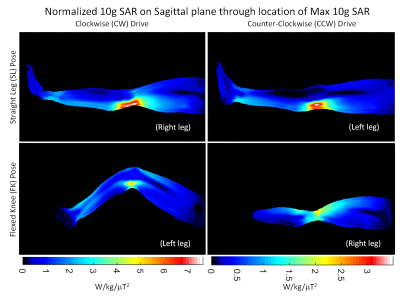 |
175 |
SAR Simulations with a Poseable Numerical Body Model for 3T MRI
of Straight & Flexed Knee: First Results
Douglas Brantner1,2 and
Christopher Collins1,2
1Radiology, NYU Grossman School of Medicine, New York, NY, United States, 2Center for Advanced Imaging Innovation and Research (CAI2R), New York University, New York, NY, United States Keywords: Safety, Safety Although recent developments in flexible coils have allowed for imaging of the knee in a flexed or straight position, simulations for safety assessment are typically performed with both legs straight. Here we show first results of SAR simulations with both legs straight versus knee flexed with fields normalized as if imaging the knee that is changing position. Results indicate a decrease in maximum 10g SAR when the knee being imaged is flexed. |
|
2701.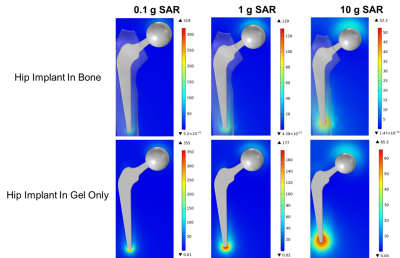 |
176 |
On the Importance of Solving for Temperature Versus Local SAR
When Evaluating RF-Induced Heating in the Magnetic Resonance
Environment
Eric David Anttila1,
Grant M Baker1,
Alan R Leewood1,
and David C Gross1
1MED Institute, West Lafayette, IN, United States Keywords: Safety, Safety Previous work has determined that solving for a weighted average local SAR is a relatively easy to way to estimate worst-case RF-induced heating in MRI. The purpose of this study was to determine the importance of solving for temperature using a sequentially coupled electromagnetics and heat transfer model versus local SAR alone when evaluating worst-case RF-induced heating. The results demonstrate that to fully capture RF-induced heating in MRI, temperature rise must be solved for using a sequentially coupled electromagnetic and heat transfer model due to the complex interplay of electric and thermal material properties for implants and the surrounding tissue. |
|
2702.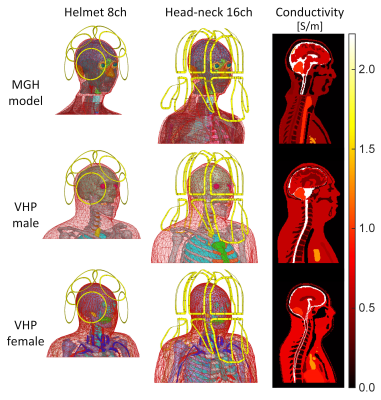 |
177 |
Reducing the number of virtual observation points when utilizing
populations of body models
Ehsan Kazemivalipour1,2,
Markus W. May3,4,
Jason P. Stockmann1,2,
Robert L. Barry1,2,
Boris Keil5,6,
Lawrence L. Wald1,2,7,
and Bastien Guerin1,2
1A. A. Martinos Center for Biomedical Imaging, Department of Radiology, Massachusetts General Hospital, Charlestown, MA, United States, 2Harvard Medical School, Boston, MA, United States, 3Erwin L. Hahn Institute for MRI, University Duisburg-Essen, Essen, Germany, 4High-Field and Hybrid MR Imaging, University Hospital Essen, Essen, Germany, 5Institute of Medical Physics and Radiation Protection, Department of Life Science Engineering, Mittelhessen University of Applied Sciences, Giessen, Germany, 6Center for Mind, Brain and Behavior (CMBB), Philipps-University Marburg, Marburg, Germany, 7Harvard-MIT Division of Health Sciences Technology, Cambridge, MA, United States Keywords: RF Pulse Design & Fields, RF Pulse Design & Fields We introduce a VOP compression scheme using “stacked E-fields” followed by the removal of linear redundancies with a positive semi-definite convex optimization problem. This method provides a lower VOP-count at a constant SAR overestimation factor compared to three other approaches when applied to 7 Tesla 8-channel and 16-channel arrays loaded with three body models, each placed at three z-positions. The “stacked E-field” method yielded a compression factor of 0.0124% and 0.0039% for the 8-channel and 16-channel arrays, respectively, and 61% and 6% fewer VOPs than the standard VOP approach that does not remove linear redundancies. |
|
2703.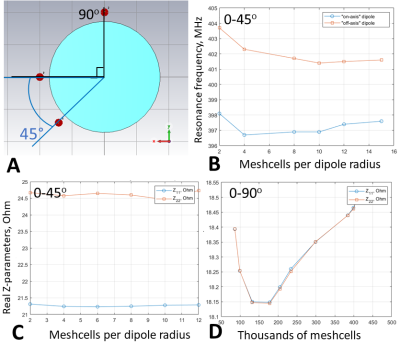 |
178 |
Numerical Evaluation of Specific Absorption Rate of Local
Transceiver Coil Arrays for Ultra-High Field MRI with Different
Local Mesh Properties
Egor Berezko1,
Georgiy Solomakha1,
Klaus Scheffler2,3,
and Nikolai Avdievich1
1High-field Magnetic Resonance, Max Planck Institute for Biological Cybernetics, Tuebingen, Germany, 2Max Planck Institute for Biological Cybernetics, Tuebingen, Germany, 3Department for Biomedical Magnetic Resonance, University of Tübingen, Tübingen, Germany Keywords: High-Field MRI, Safety Home-built RF UHF MRI coils have to be carefully evaluated for safety issues. This is performed by simulating the coil model, which often include thin conductors, loaded by a human voxel model. Currently such models are available mainly for time-domain solvers. Fine mesh over conductors and the large voxel model may lead to time-consuming simulations. Therefore, for smaller head-sized coils, the model has to be cut and the proper mesh size chosen. In this work, we numerically investigated the dependence of B1+ and SAR for four different head coils on fine local meshing and the size of the voxel model. |
|
2704.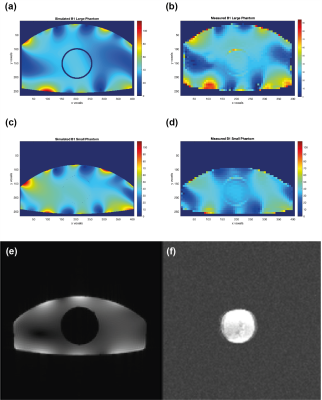 |
179 |
Numerical Simulation of SAR for a dual-frequency 1H/19F Body
Coil array at 3 Tesla
Paul Mcelhinney1,
Sarah Allwood-Spiers2,
Graeme Keith1,
Belinda Ding3,
David Brennan4,
Natasha Fullerton2,
Celestine Santosh2,4,
David Porter 1,
and Shajan Gunamony1,5
1Imaging Centre of Excellence, University of Glasgow, Glasgow, United Kingdom, 2NHS Greater Glasgow & Clyde, Glasgow, United Kingdom, 3Siemens Healthcare Limited, Frimley, United Kingdom, 4Aurum Biosciences Limited, Glasgow, United Kingdom, 5MR CoilTech Limited, Glasgow, United Kingdom Keywords: RF Arrays & Systems, Shims An eight-channel transceiver 1H/19F dual-frequency 3-Tesla body array has been developed to investigate the use of a perfluorocarbon (PFC) compound for use in as diagnostic tool in the investigation of inflammation inside the human body. Dual-frequency operation enables the same coil to be used at both frequencies, which reduces scan time, improves patient comfort, and provides accurate anatomic localisation. This RF coil consists of 8 transceiver elements, with four in each posterior and anterior half. This abstract presents the electromagnetic (EM) simulations for B1+ homogenisation, SAR assessment and validation of the dual-frequency array. |
|
The International Society for Magnetic Resonance in Medicine is accredited by the Accreditation Council for Continuing Medical Education to provide continuing medical education for physicians.